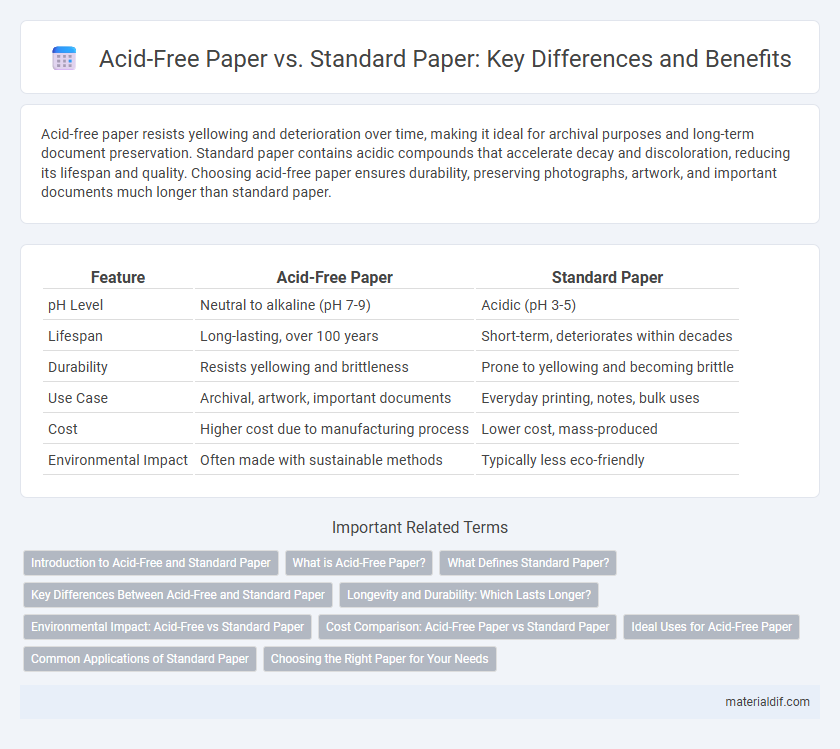Acid-free paper resists yellowing and deterioration over time, making it ideal for archival purposes and long-term document preservation. Standard paper contains acidic compounds that accelerate decay and discoloration, reducing its lifespan and quality. Choosing acid-free paper ensures durability, preserving photographs, artwork, and important documents much longer than standard paper.
Table of Comparison
| Feature | Acid-Free Paper | Standard Paper |
|---|---|---|
| pH Level | Neutral to alkaline (pH 7-9) | Acidic (pH 3-5) |
| Lifespan | Long-lasting, over 100 years | Short-term, deteriorates within decades |
| Durability | Resists yellowing and brittleness | Prone to yellowing and becoming brittle |
| Use Case | Archival, artwork, important documents | Everyday printing, notes, bulk uses |
| Cost | Higher cost due to manufacturing process | Lower cost, mass-produced |
| Environmental Impact | Often made with sustainable methods | Typically less eco-friendly |
Introduction to Acid-Free and Standard Paper
Acid-free paper is manufactured to have a neutral or slightly alkaline pH, preventing yellowing and deterioration over time, making it ideal for archival documents and artwork. Standard paper typically contains acidic lignin and chemicals that cause it to become brittle and discolored with age. Choosing acid-free paper ensures longevity and preservation, especially important for important documents and high-quality printing.
What is Acid-Free Paper?
Acid-free paper is manufactured with a neutral or alkaline pH, typically around 7 or higher, preventing yellowing and deterioration over time. It is made using calcium carbonate or other buffering agents that neutralize acids and increase the paper's durability, making it ideal for archival, legal, and artistic uses. Standard paper, by contrast, contains acidic components that cause it to become brittle and discolored, reducing its lifespan significantly.
What Defines Standard Paper?
Standard paper is typically made from wood pulp containing lignin, which causes it to yellow and deteriorate over time due to acid content. It often has a lower pH level, making it less durable and prone to becoming brittle. This type of paper is commonly used for everyday printing and copying tasks where longevity is not a primary concern.
Key Differences Between Acid-Free and Standard Paper
Acid-free paper is manufactured using a neutral or alkaline pH process, ensuring longevity and resistance to yellowing and deterioration, unlike standard paper which often contains acidic components that cause it to degrade over time. The absence of acid in acid-free paper makes it ideal for archival purposes, scrapbooking, and artwork preservation, whereas standard paper is typically suited for everyday printing and temporary documents. Key differences also include durability, with acid-free paper maintaining physical integrity for decades, while standard paper may become brittle and discolored within a shorter lifespan.
Longevity and Durability: Which Lasts Longer?
Acid-free paper significantly outperforms standard paper in longevity and durability due to its neutral pH, which prevents yellowing and brittle degradation over time. Standard paper, containing acidic compounds, tends to deteriorate faster, compromising the preservation of documents, artworks, and photographs. For archival purposes and long-term storage, acid-free paper is the preferred choice to ensure materials remain intact and legible for decades.
Environmental Impact: Acid-Free vs Standard Paper
Acid-free paper significantly reduces environmental impact by preventing the release of harmful acids during decomposition, which can contaminate soil and water. Standard paper often contains acidic compounds that accelerate degradation and contribute to pollution in landfills and recycling processes. Using acid-free paper supports sustainable forestry practices and enhances paper recyclability, promoting a healthier ecosystem.
Cost Comparison: Acid-Free Paper vs Standard Paper
Acid-free paper typically costs 20-50% more than standard paper due to its higher manufacturing quality and longevity features. While standard paper is cheaper upfront, acid-free paper offers better durability and resistance to yellowing over time, which can reduce replacement expenses for archival or important documents. The long-term investment in acid-free paper often outweighs initial cost savings from choosing standard paper.
Ideal Uses for Acid-Free Paper
Acid-free paper is ideal for archival documents, artwork, and important legal or historical records due to its longevity and resistance to yellowing and deterioration. Museums, libraries, and professionals in preserving photographs or certificates prefer acid-free paper to ensure materials remain intact for decades. This durability makes acid-free paper essential for scrapbooking, fine art printing, and any project requiring long-term preservation.
Common Applications of Standard Paper
Standard paper is widely used in everyday printing and copying due to its affordability and availability. Common applications include school notebooks, flyers, newspapers, and general office documents that do not require long-term preservation. Its lower resistance to yellowing and deterioration makes it suitable for short-term projects and mass-produced materials.
Choosing the Right Paper for Your Needs
Acid-free paper offers superior durability and resistance to yellowing, making it ideal for archival documents, artwork, and important records that require longevity. Standard paper, typically containing acidic components, suits everyday printing and short-term use but may deteriorate over time. Selecting the right paper depends on the intended purpose, with acid-free choices favored for preservation and standard paper appropriate for routine tasks.
Acid-Free Paper vs Standard Paper Infographic

 materialdif.com
materialdif.com